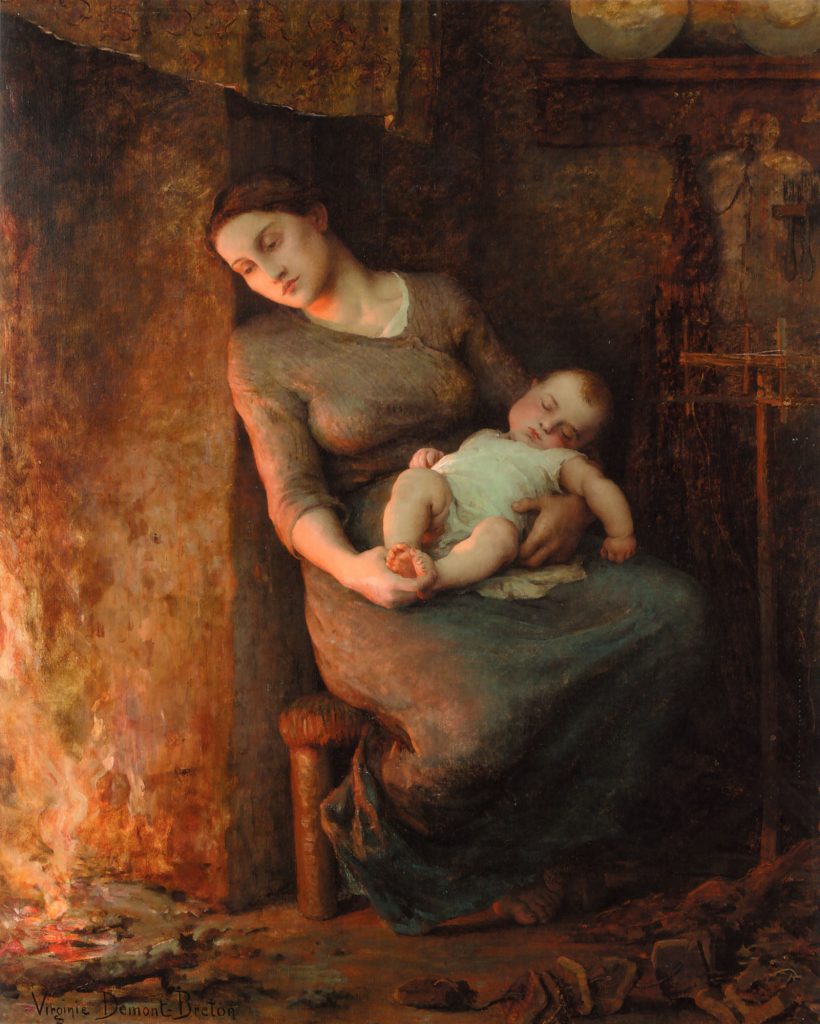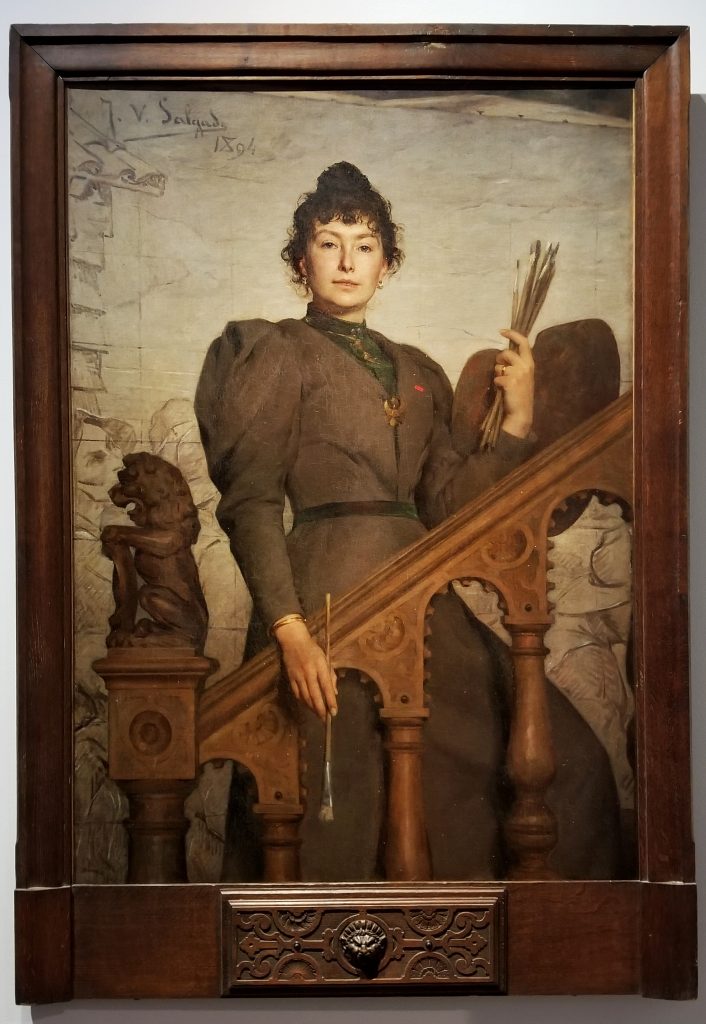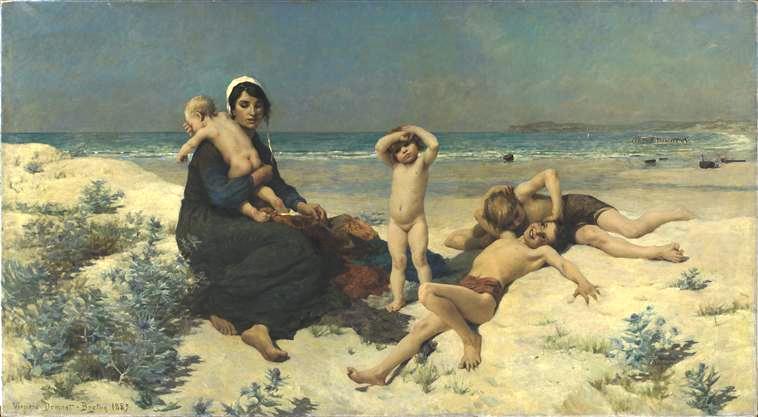50 Chapter 12: Virginie Demont-Breton
The Union of Women: The Beginning of New Women Artists
Sofia Garcia Hernandez
Audio recording of chapter is available here:


Art was an essential component of the world during the 19th and 20th centuries. Many men, such as Claude Monet, Vincent Van Gogh, Pablo Picasso, Henri Matisse, etc. became famous artists during the 19th and 20th centuries because of their beautiful paintings. However, very few women were mentioned in the art world during that time. A famous essay that was published in 1971 written by Linda Nochlin titled “Why Have There Been No Great Women Artists?” has had a significant impact on society and has demonstrated how women were excluded from the art world.[1] Having women in the art world was and continues to be a significant issue, however women were at a disadvantage in education compared to men in the 1800s, making it difficult for almost all of them to have the opportunity to become artists. The effort and determination of Virginie Demont-Breton, a female artist, during the 19th-20th century allowed many women to obtain the opportunity they desired to have access to art, making a new beginning where women were going to be included in the art world.

Virginie Élodie Marie Thérèse Demont-Breton was a French woman artist who grew up surrounded by painters, including her father and uncle.[2] Virginie’s father, Jules Breton, was a French naturalist painter who introduced his daughter to many famous painters, such as Rosa Bonheur. Demont-Breton became very familiar with Bonheur, who was best known as a painter of animals and her sculptures in a Realist style. Bonheur was a significant influence, a role model, and a mentor to Demont-Breton during her artistic career. This great animal painter was very passionate about art. She pursued her artistic career with unwavering zeal.[3] Little did Bonheur know that she would progress to the proud position of one of the greatest modern animal painters. Her enthusiasm and courage in art resulted in her important achievements; no wonder she was a significant influence on Demont-Breton.[4]
Although it is not known exactly when Demont-Breton started her artistic training, it is presumed that she finished one of her first drawings, titled Young Woman Sewing, at fourteen years old when she had just started to depict figures.[5] Demont-Breton was passionate about art which can be demonstrated since she started to paint at a young age. Her passion for art led her to the Salon, where she would win many honourable mentions and medals. When Demont-Breton achieved her second gold medal, she became determined to secure the entrance of women to the Ecole, and she then became an essential part of including women in the art world.[6]

During the last quarter of the nineteenth century and the first decade and a half of the twentieth century, there were unprecedented institutional initiatives for women who were artists. A significant event happening during those years; the first all-women artists’ exhibition and the first organization of women artists were founded. The Union of Woman Painters and Sculptures constituted the primary campaigning body for women’s entry into state educational institutions.[7] From 1895 to 1901, Demont-Breton served as president of the Union of Women Painters and Sculptors. In collaboration with Helene Bertaux, a French sculptor and women’s rights advocate, they were granted their first audience with a commission from the Ecole trying to get women to be admitted.[8] Although it was not easy to achieve the inclusion of women in art, Demont-Breton did not give up, and in 1897 she and Bertaux achieved the goal they had worked on for a long time; the Ecole de Beaux Arts was finally opened to female students. Perhaps it does not seem as much of a problem in today’s world, but it was very significant back then, because female art students were not socially free in Paris and this challenged the logic of universal rights held by French Republicans. It went against the claim of equality and justice for all.[9] Demont-Breton did not only receive honourable mentions; she was able to have exhibitions of her work and won medals because of it. However, she marked the beginning of a new world for women, she made sure that female artists were allowed to be present in academic settings and be able to pursue their dreams in the art world.

Bibliography
Clausen, Meredith L. “The Ecole Des Beaux-Arts: Toward a Gendered History.” Journal of the Society of Architectural Historians 69, no. 2 (2010): 153–61. https://doi.org/10.1525/jsah.2010.69.2.153.
Errika Gerakiti, “Why Have There Been No Great Women Artists? 50 Years Later.” Daily Art Magazine, 2022. https://www.dailyartmagazine.com/why-have-there-been-no-great-women-artists/
Garb, Tamar. “Revising the Revisionists: The Formation of the Union Des Femmes Peintres et Sculpteurs.” Art Journal 48, no. 1 (1989): 63–70. https://doi.org/10.2307/776922.
Radycki, J. Diane. “The Life of Lady Art Students: Changing Art Education at the Turn of the Century.” Art Journal 42, no. 1 (1982): 9–13. https://doi.org/10.2307/776485.
Radycki, Diane. Review of “Sisters of the Brush: Women’s Artists Culture in Late Nineteenth-Century Paris, by Tamar Garb.” Woman’s Art Journal 18, no. 1 (1997): 53–54. https://doi.org/10.2307/1358684.
“Rosa Bonheur.” Cosmopolitan Art Journal 2, no. 4 (1858): 193–94. http://www.jstor.org/stable/20487240.
Sidlauskas, Susan. “Contesting Femininity: Vuillard’s Family Pictures.” The Art Bulletin 79, no. 1 (1997): 85–111. https://doi.org/10.2307/3046231.
“Virginie Demont-Breton, ‘Young Woman Sewing.’” Musée D’Orsay. n.d. Accessed October 21, 2022. https://www.musee-orsay.fr/en/articles/virginie-demont-breton-young-woman-sewing-200939.
- Errika Gerakiti, “Why Have There Been No Great Women Artists? 50 Years Later,” Daily Art Magazine, 2022, https://www.dailyartmagazine.com/why-have-there-been-no-great-women-artists/ ↵
- Wikipedia, s.v. "Virginie Demont-Breton,” last modified August 9, 2022, 18:34 UTC, https://en.wikipedia.org/wiki/Virginie_Demont-Breton. ↵
- “Rosa Bonheur,” Cosmopolitan Art Journal 2, no. 4 (1858): 193–94. http://www.jstor.org/stable/20487240. ↵
- “Rosa Bonheur,” Cosmopolitan Art Journal 2, 193-94. ↵
- “Virginie Demont-Breton, ‘Young Woman Sewing,’" Musée d’Orsay, accessed on October 20, 2022, https://www.musee-orsay.fr/en/articles/virginie-demont-breton-young-woman-sewing-200939 ↵
- Radycki, J. Diane. “The Life of Lady Art Students: Changing Art Education at the Turn of the Century.” Art Journal 42, no. 1 (1982): 9–13. https://doi.org/10.2307/776485. ↵
- Garb, Tamar. “Revising the Revisionists: The Formation of the Union Des Femmes Peintres et Sculpteurs.” Art Journal 48, no. 1 (1989): 63–70. https://doi.org/10.2307/776922. ↵
- Radycki, J. Diane. “The Life of Lady Art Students: Changing Art Education at the Turn of the Century.” Art Journal 42, 9-13. ↵
- Clausen, Meredith L. “The Ecole Des Beaux-Arts: Toward a Gendered History.” Journal of the Society of Architectural Historians 69, no. 2 (2010): 153–61. https://doi.org/10.1525/jsah.2010.69.2.153. ↵

